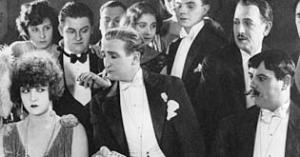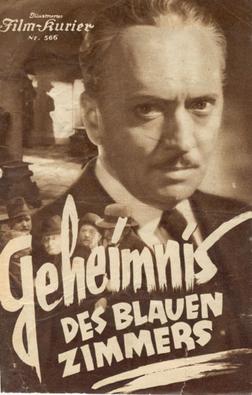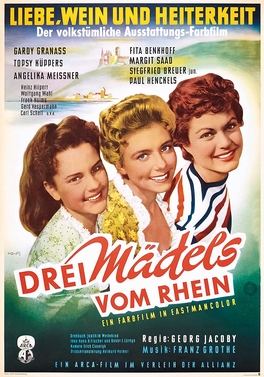
The Last Company is a 1930 German war film directed by Curtis Bernhardt and starring Conrad Veidt, Karin Evans and Erwin Kalser. It was part of the popular cycle of Prussian films which portrayed patriotic scenes from Prussian history. It was shot at the Babelsberg Studios of UFA in Berlin. The film's art direction was overseen by Andrej Andrejew who designed the film's sets. It was shot on location around Havelland in Brandenburg. It is also known by the alternative title Thirteen Men and a Girl. It was later remade in 1967 as A Handful of Heroes.
Der Ladenprinz is a 1928 German silent film directed by Erich Schönfelder, starring Harry Halm, La Jana and Paul Henckels and also with La Jana, Sig Arno and Hermine Sterler. It was adapted from a novel by Kurt Münzer. The film's art direction was by Andrej Andrejew.

Charley's Aunt is a 1934 German comedy film directed by Robert A. Stemmle and starring Fritz Rasp, Paul Kemp, and Max Gülstorff. It is based on the British writer Brandon Thomas's 1892 play Charley's Aunt. The film's sets were designed by art director Franz Schroedter.

The Prince and the Dancer is a 1926 German silent film directed by Richard Eichberg and starring Willy Fritsch, Lucy Doraine and Hans Albers. The film was shot at the Johannisthal Studios with sets designed by the art director Kurt Richter. It premiered at the Gloria-Palast in Berlin.
The Brandenburg Arch is a 1929 German silent drama film directed by Max Knaake and William Dieterle and starring Paul Henckels, June Marlowe and Aribert Mog. It was made by the German branch of Universal Pictures.
The Love of the Brothers Rott is a 1929 German silent film directed by Erich Waschneck and starring Olga Chekhova, Jean Dax and Paul Henckels. It was shot at the Staaken Studios in Berlin. The film's sets were designed by the art director Andrej Andrejew.
Love's Joys and Woes is a 1926 German silent comedy film and directed by Kurt Gerron and Heinz Schall and starring Charlotte Susa, Margarete Kupfer and Hilde Maroff.

Holiday From Myself is a 1952 West German comedy film directed by Hans Deppe and starring Rudolf Prack, Marianne Hold and Willy Fritsch. It was shot at the Göttingen Studios with sets designed by the art director Ernst H. Albrecht. It is a remake of Deppe's 1934 film of the same title.

Klettermaxe is a 1952 West German comedy crime film directed by Kurt Hoffmann and starring Liselotte Pulver, Albert Lieven and Charlott Daudert.

I'll Never Forget That Night is a 1949 German comedy film directed by Johannes Meyer and starring Gustav Fröhlich, Winnie Markus and Paul Henckels. It was shot at the Bendestorf Studios near Hamburg. The film's sets were designed by the art director Erich Grave.

This One or None is a 1932 German musical film directed by Carl Froelich and starring Gitta Alpar, Max Hansen and Ferdinand von Alten. It is part of the tradition of operetta films. It was shot at the Johannisthal Studios in Berlin. The film's sets were designed by the art director Franz Schroedter. Location shooting took place around Berlin at the Brandenburg Gate, Potsdamer Platz and Unter den Linden.

She and the Three is a 1935 German comedy crime film directed by Victor Janson and starring Gustav Waldau, Charlotte Susa and Hubert von Meyerinck.

The Tiger Murder Case is a 1930 German mystery film directed by Johannes Meyer and starring Charlotte Susa, Harry Frank and Hertha von Walther. It was shot at the Babelsberg Studios in Berlin. The film's sets were designed by the art director Willi Herrmann.
The Stolen Face is a 1930 German crime film directed by Philipp Lothar Mayring and Erich Schmidt, starring Hans Otto, Friedl Haerlin and Max Adalbert.

Flachsmann the Educator is a 1930 German comedy film directed by Carl Heinz Wolff and starring Paul Henckels, Charlotte Ander and Alfred Braun. It was shot at the Babelsberg Studios in Berlin. The film's sets were designed by the art director Willi Herrmann.

The Glass Ball is a 1937 German drama film directed by Peter Stanchina and starring Albrecht Schoenhals, Sabine Peters, and Hilde von Stolz.

Dudu, a Human Destiny is a 1924 German silent film directed by Rudolf Meinert and starring Alfred Abel, Robert Garrison, and Maly Delschaft. It is part of the tradition of circus films.

Geheimnis des blauen Zimmers is a 1932 German mystery film directed by Erich Engels and starring Theodor Loos, Else Elster and Hans Adalbert Schlettow.

The Paw is a 1931 German thriller film directed by Hans Steinhoff and starring Charlotte Susa, Hans Rehmann, and Fritz Rasp. It was made as a co-production with the Italian Cines Studios. The film's sets were designed by the art director Daniele Crespi. A separate Italian version The Man with the Claw was also made.

Three Girls from the Rhine is a 1955 West German comedy film directed by Georg Jacoby and starring Gardy Granass, Margit Saad and Fita Benkhoff. It was shot at the Tempelhof and Spandau Studios in West Berlin and the Wandsbek Studios in Hamburg. Filmed in Eastmancolor, location shooting took place in the Mosel including around Zell and at Schloss Lieser. The film's sets were designed by the art directors Erich Kettelhut and Johannes Ott.















